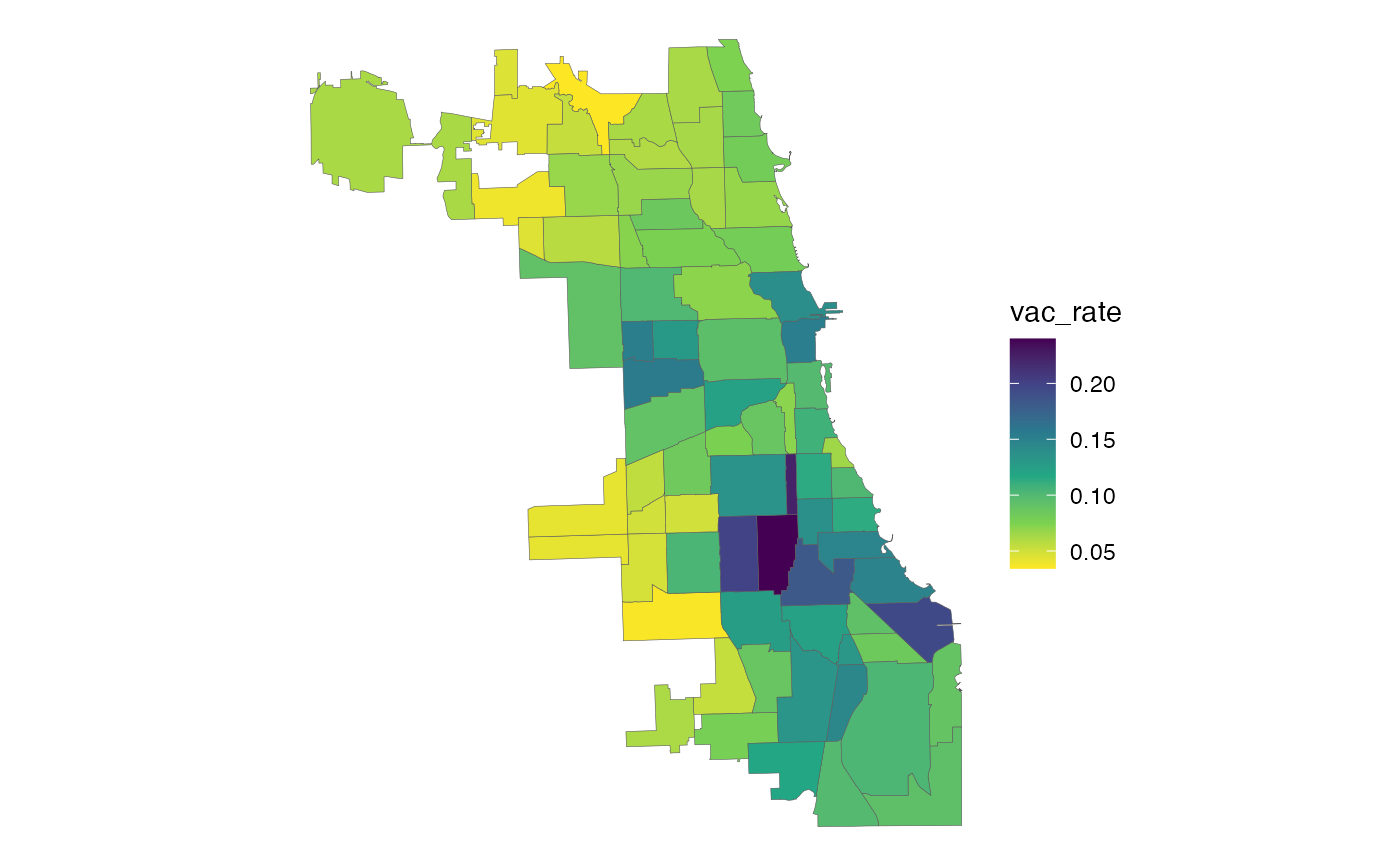This table contains a set of factors to apportion Census block group-level
data among Chicago Community Areas (CCAs). Separate factors are provided for
apportioning housing unit, household, and population attributes. All factors
were determined by calculating the percentage of a block group's housing
units, households and population that were located in each of its component
blocks, according to the 2020 Decennial Census, and then assigning each block
to a CCA (based on the location of the block's centroid point). Use
xwalk_blockgroup2cca for data from the 2020 decennial census or the
American Community Survey (ACS) from 2020 onward. For data from the 2010
decennial census or ACS from 2010 through 2019, use
xwalk_blockgroup2cca_2010.
xwalk_blockgroup2cca
xwalk_blockgroup2cca_2010Format
xwalk_blockgroup2cca is a tibble with 2185 rows
and 6 variables:
- geoid_blkgrp
Unique 12-digit block group ID, assigned by the Census Bureau. Corresponds to
blockgroup_sf. Character.- cca_num
Numeric CCA ID, as assigned by the City of Chicago. Corresponds to
cca_sf. Integer.- hu_pct
Proportion of the block group's housing units (occupied or vacant) located in the specified CCA. Multiply this by a block group-level measure of a housing attribute (e.g. vacant homes) to estimate the CCA's portion. Double.
- hh_pct
Proportion of the block group's households (i.e. occupied housing units) living in the specified CCA. Multiply this by a block group-level measure of a household attribute (e.g. car-free households) to estimate the CCA's portion.Double.
- pop_pct
Proportion of the block group's total population (including group quarters) living in the specified CCA. Multiply this by a block group-level measure of a population attribute (e.g. race/ethnicity) to estimate the CCA's portion. Double.
- emp_pct
Proportion of the block group's total jobs located in the specified CCA. Multiply this by a block group-level measure of an employment attribute (e.g. retail jobs) to estimate the CCA's portion. Not available in
xwalk_blockgroup2cca_2010. Double.
xwalk_blockgroup2cca_2010 is a tibble with
2180 rows and
5 variables (no emp_pct).
Details
Generally speaking, block group boundaries align neatly with CCA boundaries as they tend to follow similar features (e.g. rivers, major roads, rail lines) but there are cases where the jobs, population, households and/or housing units in a block group are split across multiple CCAs, or else are partially within the City of Chicago and partially outside of it. For that reason, it is not appropriate to use a one-to-one block group-to-CCA assignment to apportion Census data among CCAs, and this crosswalk should be used instead.
To use this crosswalk effectively, Census data should be joined to it (not
vice versa, since block group IDs appear multiple times in this table). Once
the data is joined, it should be multiplied by the appropriate factor
(depending whether the data of interest is measured at the housing unit,
household, person or job level), and then the result should be summed by CCA.
If calculating rates, this should only be done after the counts have been
summed to CCA. The resulting table can then be joined to cca_sf for
mapping, if desired.
If your data is only available at the tract level, you can use
xwalk_tract2cca for a tract-level allocation instead.
Examples
suppressPackageStartupMessages(library(dplyr))
# View the block groups with housing units split between multiple CCAs
filter(xwalk_blockgroup2cca, hu_pct < 1)
#> # A tibble: 33 × 6
#> geoid_blkgrp cca_num hu_pct hh_pct pop_pct emp_pct
#> <chr> <int> <dbl> <dbl> <dbl> <dbl>
#> 1 170310619024 6 1 1 1 1
#> 2 170310701012 7 1 1 1 1
#> 3 170310814031 32 0 0 0 0.306
#> 4 170311611002 15 0 0 0 0.262
#> 5 170314304001 69 0 0 0 0.125
#> 6 170315205003 52 0.992 0.992 0.981 1
#> 7 170315205003 55 0.00816 0.00833 0.0187 0
#> 8 170315206001 52 0.993 0.993 0.981 1
#> 9 170315206001 55 0.00712 0.00738 0.0194 0
#> 10 170315502002 54 0 0 0 0.00881
#> # ℹ 23 more rows
# Estimate CCA-level housing vacancy rates from block group-level Census data
df_blkgrp <- tidycensus::get_decennial(
geography = "block group", variables = c("H1_001N", "H1_003N"),
year = 2020, state = "IL", county = c("031", "043"), output = "wide"
) %>%
suppressMessages() %>% # Hide tidycensus messages
select(geoid_blkgrp = GEOID, hu_tot = H1_001N, hu_vac = H1_003N)
df_cca <- xwalk_blockgroup2cca %>%
left_join(df_blkgrp, by = "geoid_blkgrp") %>%
mutate(hu_tot = hu_tot * hu_pct,
hu_vac = hu_vac * hu_pct) %>%
group_by(cca_num) %>%
summarize_at(vars(hu_tot, hu_vac), sum) %>%
mutate(vac_rate = hu_vac / hu_tot)
df_cca
#> # A tibble: 77 × 4
#> cca_num hu_tot hu_vac vac_rate
#> <int> <dbl> <dbl> <dbl>
#> 1 1 28531 2129 0.0746
#> 2 2 28249 1756 0.0622
#> 3 3 35019 2804 0.0801
#> 4 4 20431 1288 0.0630
#> 5 5 15936 1005 0.0631
#> 6 6 61920 4199 0.0678
#> 7 7 38649 3079 0.0797
#> 8 8 77429 10744 0.139
#> 9 9 4960 227 0.0458
#> 10 10 16035 704. 0.0439
#> # ℹ 67 more rows
# Join to cca_sf for mapping
library(ggplot2)
cca_sf %>%
left_join(df_cca, by = "cca_num") %>%
ggplot() +
geom_sf(aes(fill = vac_rate), lwd = 0.1) +
scale_fill_viridis_c(direction = -1) +
theme_void()
